Qualcomm Snapdragon S4 (Krait) Performance Preview - 1.5 GHz MSM8960 MDP and Adreno 225 Benchmarks
by Brian Klug & Anand Lal Shimpi on February 21, 2012 3:01 AM EST- Posted in
- Smartphones
- Snapdragon
- Qualcomm
- Adreno
- Krait
- Mobile
The MSM8960 is an unusual member of the Krait family in that it doesn't use an Adreno 3xx GPU. In order to get the SoC out quickly, Qualcomm paired the two Krait cores in the 8960 with a tried and true GPU design: the Adreno 225. Adreno 225 itself hasn't been used in any prior Qualcomm SoC, but it is very closely related to the Adreno 220 used in the Snapdragon S3 that we've seen in a number of recent handsets.
Compared to Adreno 220, 225 primarily adds support for Direct3D 9_3 (which includes features like multiple render targets). The resulting impact on die area is around 5% and required several months of work on Qualcomm's part.
From a compute standpoint however, Adreno 225 looks identical to Adreno 220. The big difference is thanks to the 8690's 28nm manufacturing process, Adreno 225 can now run at up to 400MHz compared to 266MHz in Adreno 220 designs. A 50% increase in GPU clock frequency combined with a doubling in memory bandwidth compared to Snapdragon S3 gives the Adreno 225 a sizable advantage over its predecessor.
| Mobile SoC GPU Comparison | |||||||||||
| Adreno 225 | PowerVR SGX 540 | PowerVR SGX 543 | PowerVR SGX 543MP2 | Mali-400 MP4 | GeForce ULP | Kal-El GeForce | |||||
| SIMD Name | - | USSE | USSE2 | USSE2 | Core | Core | Core | ||||
| # of SIMDs | 8 | 4 | 4 | 8 | 4 + 1 | 8 | 12 | ||||
| MADs per SIMD | 4 | 2 | 4 | 4 | 4 / 2 | 1 | 1 | ||||
| Total MADs | 32 | 8 | 16 | 32 | 18 | 8 | 12 | ||||
| GFLOPS @ 200MHz | 12.8 GFLOPS | 3.2 GFLOPS | 6.4 GFLOPS | 12.8 GFLOPS | 7.2 GFLOPS | 3.2 GFLOPS | 4.8 GFLOPS | ||||
| GFLOPS @ 300MHz | 19.2 GFLOPS | 4.8 GFLOPS | 9.6 GFLOPS | 19.2 GFLOPS | 10.8 GFLOPS | 4.8 GFLOPS | 7.2 GFLOPS | ||||
We turn to GLBenchmark and Basemark ES 2.0 V1 to measure the Adreno 225's performance:
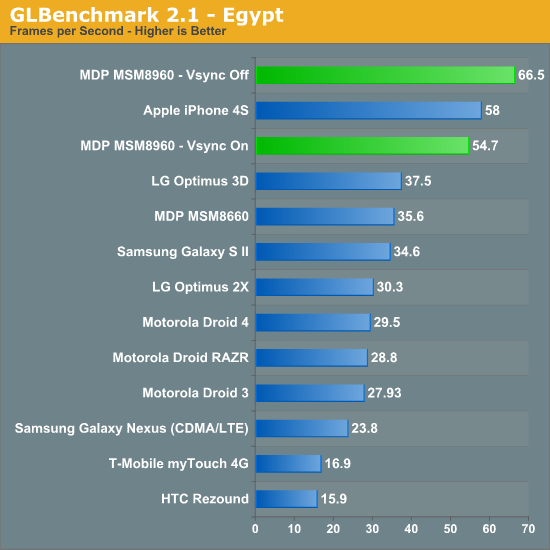
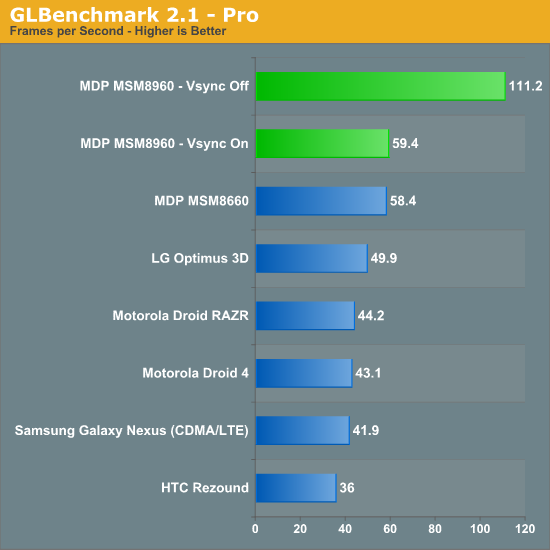
Limited by Vsync the Adreno 225 can actually deliver similar performance to the PowerVR SGX 543MP2 in Apple's A5. However if we drive up the resolution, avoid vsync entirely and look at 720p results the Adreno 225 falls short. Its performance is measurably better than anything else available on the Android side in the Egypt benchmark, however the older Pro test still shows the SGS2's Mali-400 implementation as quicker. The eventual move to Adreno 3xx GPUs will likely help address this gap.

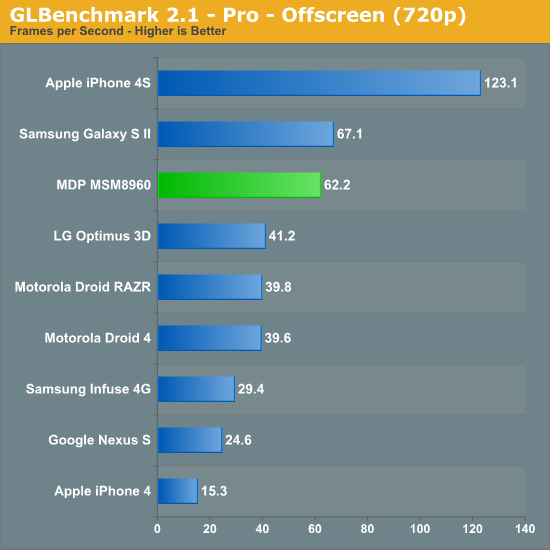
Basemark ES 2.0 tells a similar story (updated: notes below):
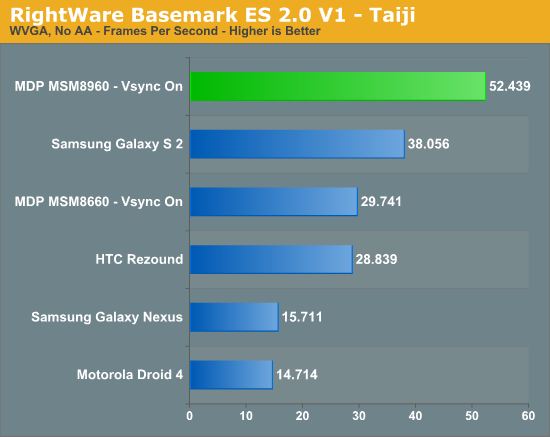
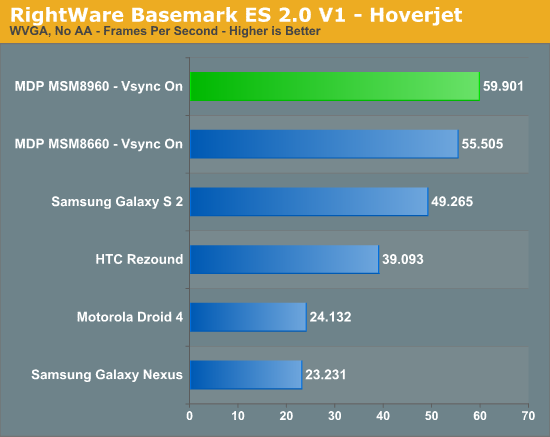
In the original version of this article we noticed some odd behavior on the part of the Mali-400 MP4 based Samsung Galaxy S 2. Initially we thought the ARM based GPU was simply faster than the Adreno 225 implementation in the MSM8960, however it turns out there was another factor at play. The original version of Basemark ES 2.0 V1 had anti-aliasing enabled and requested 4X MSAA from all devices that ran it. Some GPUs will run the test with AA disabled for various reasons (e.g. some don't technically support 4X MSAA), while others (Adreno family included) will run with it enabled. This resulted in the Adreno GPUs being unfairly penalized. We've since re-run all of the numbers with AA disabled and at WVGA (to avoid hitting vsync on many of the devices).
Basemark clearly favors Qualcomm's Adreno architecture, whether or not that's representative of real world workloads is another discussion entirely.
The results above are at 800 x 480. We're unable to force display resolution on the iOS version of Basemark so we've got a native resolution comparison below:
| RightWare Basemark ES 2.0 V1 Comparison (Native Resolution) | ||||
| Taiji | Hoverjet | |||
| Apple iPhone 4S (960 x 640) | 16.623 fps | 30.178 fps | ||
| Qualcomm MDP MSM8960 (1024 x 600) | 40.576 fps | 59.586 fps | ||
Even at its lower native resolution, Apple's iPhone 4S is unable to outperform the MSM8960 based MDP here. It's unclear why there's such a drastic reversal in standing between the Adreno 225 and PowerVR SGX 543MP2 compared to the GLBenchmark results. Needless to say, 3D performance can easily vary depending on the workload. We're still in dire need of good 3D game benchmarks on Android. Here's hoping that some cross platform iOS/Android game developers using Epic's UDK will expose frame rate counters/benchmarking tools in their games.










86 Comments
View All Comments
ssj4Gogeta - Tuesday, February 21, 2012 - link
I think he meant lower compared to the 720p GLBenchmark where the A5 wins.zanon - Tuesday, February 21, 2012 - link
I agree the wording is a bit awkward there since they are both driving identical numbers of pixels. If he meant to compare it to the earlier 720p results it'd probably be better to make that explicit.jjj - Tuesday, February 21, 2012 - link
Looks like it's faster than Tegra 3 and with single threaded perf certainly much better the only remaining big question is power consumption.Malih - Tuesday, February 21, 2012 - link
I've been my old android device that comes with Android 1.6, and Cyanogenmod-ded to Gingerbread (it's not so responsive when running more than one app), because I need the new version of the Gmail app.Malih - Tuesday, February 21, 2012 - link
correction: I've been *using* my old...In short: it looks like I'll be waiting in line for a smartphone with this SoC
Zingam - Tuesday, February 21, 2012 - link
I haven't been impressed by a CPU/GPU for years but this thing looks amazing! If they manage to go on like that we'll soon have a true ARM desktop experience.Great job! I wish now they support the latest DirectX/OpenGL/OpenCL/OpenVG etc. stuff and we'll have it!!! It is unimaginable what ARM based SoCs would deliver when the time for 14nm comes.
Torrijos - Tuesday, February 21, 2012 - link
Since both devices actually render the same amount of pixel but with different aspect ratio, would it be possible, that the performance hit seen for the iPhone 4S, is the result of graphics rendered in a standard aspect ratio (16:9 or something else) then having to be transformed to fit the particular screen?cosminmcm - Tuesday, February 21, 2012 - link
Maybe it's because at the lower resolution the faster CPU on the Krait (newer architecture with higher clocks) matters more than the faster GPU on the A5. When the resolution grows, the difference between the GPU becomes more apparent.LetsGo - Tuesday, February 21, 2012 - link
What difference?http://blogs.unity3d.com/wp-content/uploads/2011/0...
metafor - Tuesday, February 21, 2012 - link
Considering Apple controls the entire software stack and the A5 silicon, it'd be pretty stupid of them to do that. And if you look at how performance scales between the iPad (4:3) and iPhone (16:9), there's no slowdown due to aspect ratio.